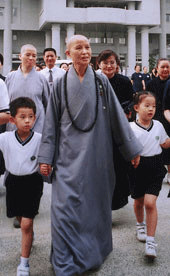Dharma Master Cheng Yen may be a 72-year-old Buddhist nun adhering to a harsh daily regimen in a convent with 160 other nuns, but that doesn’t mean she’s missing out on the latest technology. Wherever she goes in her small temple abode in eastern Taiwan or in the sprawling office complex she oversees nearby, television screens are close by, including two where morning service is held. She presides over a daily videoconference and, from the computer on her desk, holds emergency meetings via Webcam and tv. In the early 1990s she was quick to get an e-mail address and start surfing the Web.
Buddhist nun adhering to a harsh daily regimen in a convent with 160 other nuns, but that doesn’t mean she’s missing out on the latest technology. Wherever she goes in her small temple abode in eastern Taiwan or in the sprawling office complex she oversees nearby, television screens are close by, including two where morning service is held. She presides over a daily videoconference and, from the computer on her desk, holds emergency meetings via Webcam and tv. In the early 1990s she was quick to get an e-mail address and start surfing the Web.
Cheng Yen is the founder and chief executive of a fast-growing charity, Taiwan Buddhist Tzu Chi Foundation, the largest noNGOvernmental organization in the Chinese world. Thanks to being so wired, she heard about the Haiti earthquake in January right after it hit. She immediately began coordinating a global fund-raising drive and dispatching relief.
Often compared with Mother Teresa, Cheng Yen and five others started Tzu Chi in 1966 when they began sewing baby shoes to raise money for the poor. Begun in a wooden hut not far from its headquarters today, Tzu Chi now enlists entrepreneurs and other lay people as volunteers and organizes itself like a corporation. The number of donors hit 1 million in 1989, the same year that Cheng Yen published her first collection of philosophical musings, Jing Si Aphorisms. But its grassroots activity really caught the public’s attention after the foreign press started criticizing Taiwan as an island of greed during a stock market bubble in 1990. The book is now available in 11 languages and has sold 3.5 million copies, and Tzu Chi’s donors number 10 million.
Cheng Yen never travels outside of Taiwan because she suffers from heart disease. But this doesn’t prevent her from taking Tzu Chi to faraway places; it has branches in 47 other countries, the largest number being in the U.S., where it has 99 field offices. Some 30% of its donors live outside of Taiwan, with the largest group–330,000–in Malaysia. Last year it raised $313 million in Taiwan and at least $30 million overseas; there’s no overall total because Tzu Chi doesn’t tally what all the branches collect. The branches are self-sustaining and seek funding from the headquarters only when necessary.
The organization is a model of efficiency: Its staff numbers just 800, bolstered by its network of 2 million volunteers, up from 30,000 only 17 years ago. By comparison, the Red Cross has fewer than 1 million volunteers, but it pays 34,000 employees. Bangladesh’s BRAC, the world’s largest NGO by number of staff, employs more than 120,000.
Since its first overseas mission in 1991 after a flood in Bangladesh, Tzu Chi’s medical and relief teams have been active in 70 countries, their signature blue shirts and white trousers visible in such far-flung places as Kosovo, Rwanda, Cambodia and North Korea. In North Korea, for many years after 1998, Tzu Chi was the only NGO allowed to hand-deliver goods to recipients, not merely drop off the supplies at harbors as other international NGOs had to do.
By Shu-Ching Jean Chen
Source: www.forbes.com




